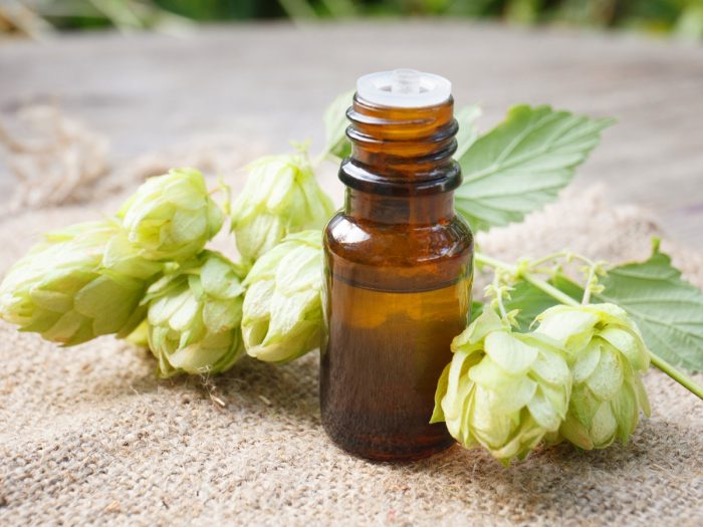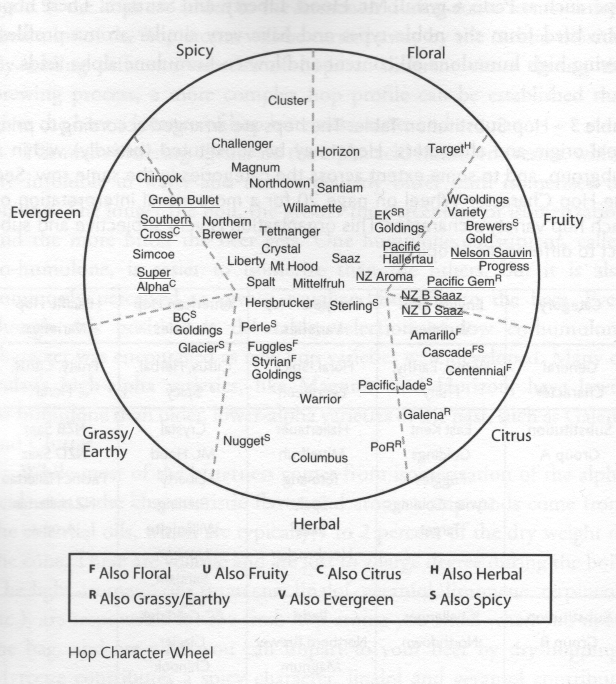"Put some oil in the hops!

Article written in collaboration with Alexandra Berry.
Overview
A hop cone consists of:
- 40-50% cellulose,
- 15% protein,
- 10% water and
- between 2 and 20% alpha acids
- up to 3% essential oils
However, although they only represent between 1 and 3% of the plant's composition, essential oils are going to be a central point of interest for brewers. Alongside the resin and alpha acids in hops that give them bitterness,the essential oils contribute to all the flavouring you find in your glass. While the alpha acids will isomerise during the boil to produce bitterness, it is the oils that are responsible for the citrus, pine or exotic fruit nuances that provide the complexity and diversity of the beer.
Hops also contain minerals, pectins, sugars, proteins, polyphenols, lypids... all of which contribute to the bitterness, flavouring, frothiness, preservation and shelf life of hops.
Although oils are only one of the weakest components of the cone, they are also one of the most important and impactful components of beer flavouring.
A little history
These chemical components were isolated almost 200 years ago, and it was Alfred Chapman who gave them a name towards the end of the 19th century. However, it was not until the invention of gas chromatography in 1950 that the 1000 chemical compounds in a hop could be identified.
By exploring hop research, scientists - and now brewers - can identify certain components by the aroma of a hop: citronellol is very green, floral and citrusy, geraniol is very floral and reminiscent of geranium (hence its name), linalool is rather 'orange'... and yet the difficulty comes when these components interact with others, such as the wort, other hops, yeast or simply when they are transformed by heat. Research continues in this area to identify more accurately these compounds and their chemical transformations in order to help brewers better control the flavouring of brews.
Indeed, some scientists hypothesise that rather than analysing the chemical components of a hop, which will always be variable, it would be better to understand and control the interactions of these components with other variables in the brewing process.
Caution...fragile oils!
In the anatomy of the hop cone, the so-called volatile oils thus only represent a maximum of 3% of the weight of the cone.
This may not sound like much, but since these oils are very concentrated, you need very little to flavour a beer.

It should also be noted that they are much more delicate than the bittering components contained in the resin. The composition of the oils in a hop will depend largely on its variety, but will still be based on hydrocarbons (between 50 and 80%) which are highly volatile and not very soluble. Hops that are particularly Aromatic and loaded with essential oils will therefore be selected for raw hopping, added at the end of the boil. They can also be added during fermentation to emphasise certain desired aromas.
It is also because of this fragility that hops must be kept cool and protected from oxygen; oxidation of the hops can occur very quickly once they are harvested. This precariousness contributes to the success of "wet hopped" or "fresh hopped" beers, brewed with freshly harvested cones.
What are the different hop oils and their characteristics?
A hop contains several types of oils, the proportions and characteristics of which will depend on the hop variety and its terroir. Below are the four main oils that you will find in your beers:
Myrcene, about 50% for the hops that contain the most
Myrcene is the dominant oil in hops, generally making up over 50% of the oils in the cone. This oil in particular does not like heat at all and heating it too much or for too long will result in the loss of the flavours of hops that contain a lot of it.
Longer boils will give you pine and citrus aromas; shorter boils will frankly reinforce the citrus and fruit side, peeled orange being something that comes out quite frequently.
Hops containing 40-50% myrcene are considered to have a high myrcene content, while the so-called "noble" hops (especially European ones) contain around 10-25%/
Here are some hops that contain high levels of myrcene oil:
Myrcene is also found in ginger and ginseng.
Humulene, about 20%.
Humulene is the second most common oil, sometimes even more concentrated than myrcene. It gives the herbaceous, woody characteristics to hops. It is also more heat resistant than myrcene and works very well at the end of the boil. If you let it boil further, it will bring out spicy notes. Some have compared its flavours to coriander or white pepper... check it out 😉
Hops containing more than 29% Humulene will be considered to have a significant level of this oil.
Here are some hops that contain high levels of myrcene oil:
Caryophyllene, about 8%.
Although found in small quantities, caryophyllene offers distinctive woody and herbal aromas, and is a major contributor to the more herbaceous beers, it is quite similar to Humulene in terms of the aromas it provides. The peppery notes of this oil make it a natural insect repellent.
New Zealand and Australian hops contain the least amount, hops with more than 15% will be considered high in Caryophyllene.
Here are some hops that contain high levels of myrcene oil:
It is found in black pepper and cloves.
Farnesene, about 6%.
This often accounts for less than 1% of the oils, although for some varieties it can be as high as 10%. It is known for its woody characteristics and is well represented by the Czech Saaz or the Tettnang.
The rest of the oils represent very small quantities but can still play a role:
- Linalool offers floral aromas such as lavender and citrus;
- citronellol is (as its name suggests) very citrusy;
- Pinene has aromas of pine, sage, rosemary and resin.
Oxygenated hydrocarbons are more soluble and aromatic. Their aromas, or those resulting from the fermentation process, will be clearer in a finished brew. These include linalool, geraniol, citronellol etc. However, this hydrocarbon will still only make up a maximum of 1% of the hop oil.
Sulfuric compounds (also known as Thiols) can also be found in minute proportions in these oils. Even in very small quantities, they are easily detectable and can greatly influence the Aromatic perception of a hop. They are difficult to measure, as they are much smaller in quantity than hydrocarbons, and require very precise and expensive equipment to detect. Yet they can impart aromas of passion fruit, tropical fruit, sauvignon blanc or other exotic flavors found in Citra, Mosaic and New Zealand hops.
In addition to the analyses (which are not systematically carried out at this level of detail for each crop and variety), it is possible to infuse the hop cones to get an idea of the main aromas that your hops will provide.
Although there are obviously variations according to terroir, year, etc., and this tool is not exhaustive, one can nevertheless get an idea of the Aromatic profile of a hop by consulting John Palmer's Hop Wheel:

How to measure and dose hop oils?
The oil of a hop is extracted by evaporatively distilling 100 grams of hops for 3 to 4 hours. The oil is then measured in millilitres of oil, for example :
1ml of oil extracted from 100g of hops = 1ml/100g = 1% hop oil
This measurement is useful for calculating the aroma of a brew, especially when brewing with cones. For example, for a late addition of hops to the brew:
2 ml/hl for 10 hl = 20 ml of oil required
20 ml ÷ 1 ml ×100 g= 2000 g of hops
For raw hopping :
4 ml/hl for 10 hl = 40 ml of oil required
40 ml ÷ 1 ml ×100 g= 4000 g of hops
These calculations will obviously depend on the recipe and style, but give an idea of the ratio of hops required to achieve a flavourful brew.
Infinite variables
Although the composition of the hops can be made available to the brewers, this will not guarantee the taste that will be imparted to the beer.
The Wye Hops Institute in England has shown that the same variety of Cascade, with the same chemical composition, will not produce the same sensory experience: the oils were the same but did not have the same taste perception (!)
Thus, theAromatic of a hop will depend not only on its chemical composition and its interaction with the brewing process, but also on the concentration of aromas in the essential oil and its perception. For example, thiols in low concentrations offer very fruity and exotic aromas, while in high concentrations these aromas can be reminiscent of cat urine.
In addition, by mixing different hops at different concentrations, synergies can occur between these different components to create something completely different, masking or emphasising certain smells and tastes. It is often the thiols that will divide beer lovers: some will find beautiful blackcurrant or wild berry aromas, while others will perceive those cat urine aromas.
Terpenes
Terpenes are increasingly used by brewers for the accuracy of flavouring that this form allows. Terpenes are a highly concentrated extract of all the oils present in a hop. It is quite expensive, but it pays for itself by the fact that very little is needed to flavour or bitter a brew, unlike the cone, for example. In addition, these extracts are analysed and measured precisely, which facilitates the preparation of the recipe in terms of boiling times and temperatures to calculate the result Aromatic and the precise IBU of a beer.
According to various brewers, terpenes also give the beer a greener, more 'dank' flavour. Exotic fruits and citrus fruits are more emphasised because they are more concentrated.
10 essential oils to recognize by their aromas:
- caryophyllene: woody
- citronellol: citrus, fruity
- farnesene: floral
- geraniol: floral, rose, geranium
- humulene: woody, pine
- limonene: citrus, orange
- linalool: floral, orange
- myrcene: green, resinous, pine
- nerol: rose, citrus
- pinene: spicy, pine
Beyond their aromatic properties, we will discover in a future article all the virtues that these essential oils of hops possess.
Stay tuned 😉
Sources:
- Hombrewing
- Barth Haas
- Beerandbrewing
- Extractionmagazine
- Naturallyinspired
- Woodske D., Hop Variety Handbook, 2013


